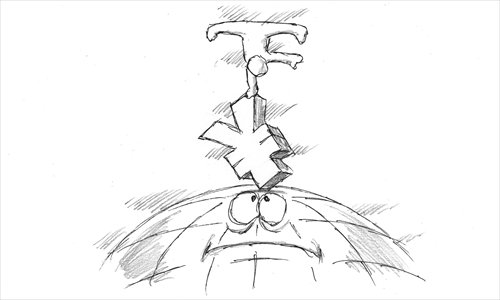HOME >> BUSINESS
China changes economic rules to seek new growth
By Jeremy Garlick Source:Global Times Published: 2016-3-8 0:18:01

Illustration: Peter C. Espina/GT
It's no secret that China's growth has been slowing in the last few years. Thus, it's not a surprise to see that the GDP growth target for 2016 has been set lower at between 6.5 and 7 percent.
The question is whether even this less ambitious target can be achieved. The recent announcement, which might have seemed shocking at first glance, that the government is intending to lay off up to 6 million State-employed workers by 2020 is indicative of the government's understanding that drastic measures are needed in order to rebalance the economy.
Supply-side structural reforms such as closures of "zombie" firms and factories, needed in order to reduce industrial overcapacity in steel and other sectors caused by slowing global demand, show that Party leaders are extremely serious about transitioning to a new economic model. Overreliance on exports as a driver of growth can no longer paper over the cracks that have appeared in the last year.
So, if the industrial sector is facing cuts, where is the necessary GDP growth going to come from? One obvious area is the domestic services sector, which is still strong and growing more rapidly than overall GDP. But, I would argue, this is not going to suffice.
Look at the developed countries, most of which are now heavily reliant on the services sector as the driver of their economies, rather than industry and exports. With the notable exception of Germany, whose industrial sector is still relatively strong, just about all of the other major economic powers are having difficulty in picking themselves up to anything resembling real growth. One of the main reasons is that they have not diversified their economies by developing sufficient alternatives to overemphasized services and their relatively moribund industrial and energy sectors.
Rather than the all-eggs-in-one-basket strategy of depending on either exports, energy or services, striving to create a balance between the three as well as actively searching for potential new areas of economic growth is, in all probability, the best way to achieve diversity in the economy. This is exactly why Premier Li Keqiang has called for innovation and entrepreneurship. He realizes that fresh creative energy is needed to generate novel industries and opportunities.
This is also what makes the ambitious "Belt and Road" initiative so important. By deciding to invest billions in developing new infrastructure, trade markets and energy supply routes across and between East Asia, Central Asia, the Middle East, Africa and Europe, the Chinese government has put down a marker for the future.
China has recognized a possibility that the developed nations have ignored: that there is a great deal of untapped growth potential in new markets, if somebody gives those nations a chance to shine. Thus there is a need for a new class of Chinese firms and entrepreneurs, coming up with innovative business ideas, to lead the way out along the so-called New Silk Road and unearth new sources of revenue.
China not only has industrial and construction overcapacity, but also a lot of recently acquired technological knowhow, so why not take a chance (as China is already doing) and build railroads, bridges, factories and skyscrapers in countries that lack the same capacity? By doing so, China is both providing work for its corporations and helping to develop emerging economies which, down the line, may generate benefits for the nation which lent a hand in the first place.
Iran is a good example. Long shut out by the West, but all the time trading with China, Iran is now likely to become a key post on the New Silk Road Economic Belt between China and Europe, while emerging as a rapidly developing economy in its own right.
All across the "Belt and Road" countries the story is similar. China, by being willing to invest in countries that the West has ignored, such as Angola, Serbia and Sudan, has given itself a head start in readjusting to the emerging new global economic realities. In the meantime, the developed countries are rapidly sinking toward stagnation due to their apparent inability to think in creative new ways about economic growth.
So it is necessary to think of rebalancing and growth targets in terms not only of shifts in China's domestic economy, but also in the way China interacts with the world. By moving economic activity outward in an innovative way, which has not been seen as possible by the developed countries who presently sit at the top of the global economic tree, China is in the process of changing the rules in a way that is not yet well understood by most observers. It is also giving itself a big advantage economically by reaching relatively undeveloped and distant lands far ahead of the competition.
The author is a lecturer in international relations at the Jan Masaryk Centre for International Studies, University of Economics in Prague. bizopinion@globaltimes.com.cn
Posted in: Columnists